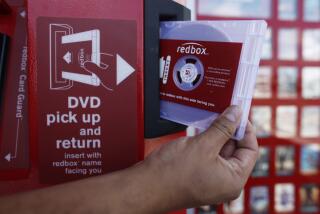After $11.6-Million Losses, CompuSave Files for Chapter 11
CompuSave Corp., after a three-year struggle against mounting losses, filed for protection from its creditors under Chapter 11 of the U.S. Bankruptcy Code on Wednesday.
The bankruptcy caps a series of misfortunes that have stricken the troubled Irvine-based maker of video shopping terminals, whose losses since its founding three years ago total $11.6 million.
According to the court filing, CompuSave currently has $3.8 million in assets and $4 million in debts to about 605 creditors. The largest creditor is owed about $132,000.
The bulk of CompuSave’s creditors consist of suppliers and other vendors, said William C. Starrett II, a Newport Beach attorney representing CompuSave. The company, he said, “has a minimal number” of secured creditors and virtually no bank debt.
The last straw for CompuSave had been its undersubscribed rights offering, which company officials hoped would raise about $5 million in badly needed cash. The offering expired last week without even coming close, said David Young, CompuSave’s chief financial officer.
While the bankruptcy itself was voluntary, Young said, the failed rights offering left CompuSave no recourse but to seek protection from creditors.
Young refused to say how far short the offering fell. However, Starrett said it raised “a hair under a million dollars.” The money, which was primarily raised from among CompuSave’s smaller shareholders, has since been returned, he added.
“Once it became apparent that the rights offering was not a success, it was just a matter of time until the company would file for bankruptcy,” said one West Coast analyst, who asked that his name not be used.
CompuSave’s woes began in mid-1985 when it went into volume production of its “Touch-and-Save” device, which allowed a user to order merchandise by inserting a credit card into the machine and pressing a touch-sensitive video screen.
Sales through the kiosks proved to be dismal, however, and CompuSave began selling the device as an in-store promotional tool for do-it-yourself retail chains.
In March, the company suffered another setback when MarketDisk Corp. of Newport Beach--its biggest customer for the device--canceled its contract.
According to documents filed with the U.S. Bankruptcy Court on Wednesday, CompuSave’s largest creditor is Sheetronics, a Torrance-based firm which it owes $132,000. Debts owed the next 19 largest creditors range from a high of $86,350 to a low of $28,408.
“The purpose of the Chapter 11 is to hold the technology in order to market it in some way,” Starrett said. “That is a sign that we’re not going to go away.” CompuSave common stock sold Wednesday in over-the-counter trading at a bid price of only 18.75 cents a share. During the last 12 months, the company’s issue sold for as much as $10.62 1/2 a share.






